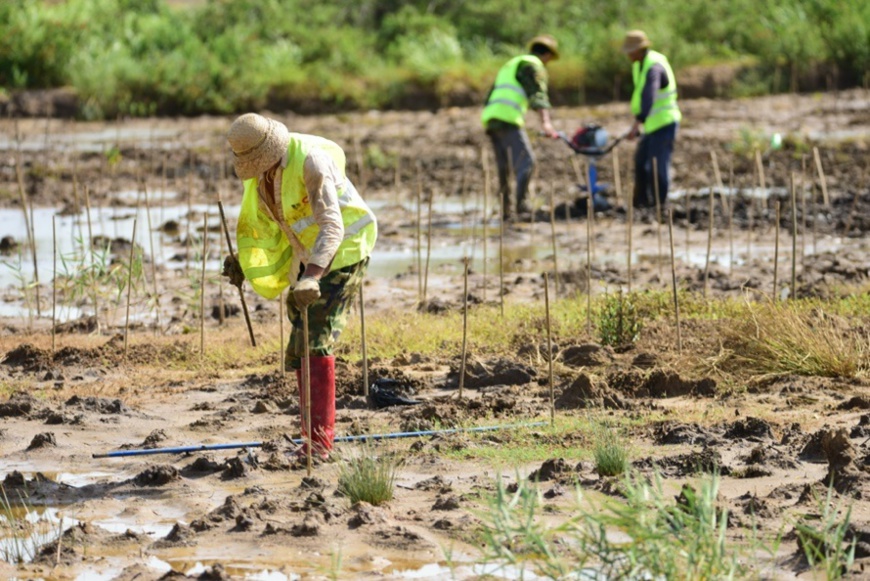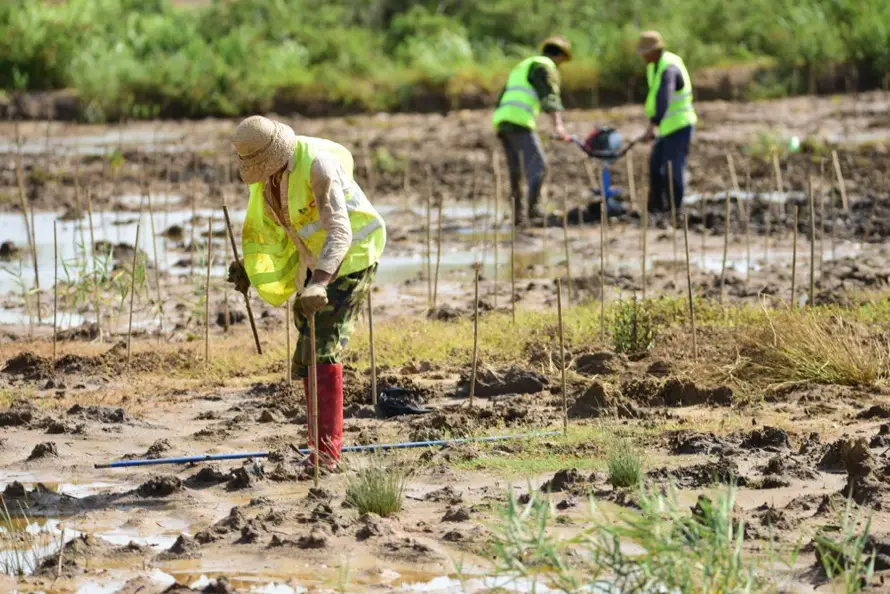By Yang Ziyan, People’s Daily Overseas Edition

Staff members plant mangrove plants on a mud flat in Hainan Dongzhaigang National Nature Reserve, South China’s Hainan Province on July 11. Photo by Meng Zhongde/ People’s Daily Online
Mangrove forests are a kind of magical phytocoenosium.
They mostly grow on tropical and subtropical intertidal zones and are immersed in periodical tidewater. They are called “forests on the sea” as they are sometimes buried in the sea water and only have the crowns above the surface, and sometimes they are completely submerged in the water so they are also nicknamed “underwater forests”.
Mangrove forests, just like coral reefs, salt marsh, and seagrass beds, belong to the marine ecosystem, but are more magical than them.
The devastating 2004 Indian Ocean tsunami happened on Dec.26. However, 172 households in a village in India’s Tamil Nadu state survived the deadly disaster, because of the luxuriant mangrove forests there.
Mangrove forests are also “heaven” for birds. According to statistics, around 100,000 migratory and transient birds of more than 190 species would winter in the Shenzhen Mangrove Nature Reserve in the northeastern coast of Shenzhen Bay, South China’s Guangdong Province every year. In a national nature reserve in Beilun Estuary, South China’s Guangxi Zhuang Autonomous Region, 283 bird species are recorded, including those under key protection in China such as egret, peregrine falcon, spoon-billed sandpiper and black-faced spoonbill.
The latest study suggests that the carbon storage in the mangrove forest per acre could be as much as 10 times more than that in forest, and carbon is sealed in the underwater soil.
Thanks to the well-developed roots of mangrove plants, mangrove forests are able to resist the impacts of tides and waves, so as to protect farmland and reduce salt injury. They are a natural perimeter of the inland.
Besides, mangrove forests are also a paradise for fish and shrimps as the plants’ roots, which are sticking underwater, offering favorable place for these little creatures to stay on and forage.
China has 37 kinds of mangrove plants, and they are mainly distributed in Guangxi, Guangdong, Hainan, Taiwan, Fujian and the southern coast of Zhejiang.
This year’s World Oceans Day also held a series of activities to promote the protection of mangrove forests, as these plants might be extinct given the pressure from both climate change and human activities.
Between 1980 and 2000, 35 percent of the worlds mangrove forests disappeared, or nearly 150,000 hectares each year, four times the amount of the global forest loss. And they are still decreasing every year at a speed of 1 to 2 percent.
In the 1950s, China was still home to 50,000 hectares of mangrove forests, but the figure plunged to 22,000 hectares in 2000.
According to Li Wuzheng, director of a mangrove reserve in Guangxi, the invasion of alien species, activities of peripheral residents, and insect pests are major threats for the plants, but human activities remain the largest one.
The land reclamation, industrial construction, pollutant discharge and seaside aquaculture in coastal cites over the recent years have caused fatal damages to the existence of mangrove forests. For some residents living by the sea, mangrove forests are like supermarkets, as when the tides are low, they would always flock to the beach for beachcombing. Some of them even shock the fish with electricity. When humans find more food in the sea, the number of fish lowers, and so does the food for birds.
Picking the fruits of avicennia marina, a species of mangrove plant, is a tradition for people in coastal Guangxi. However, such practice almost once wiped out the species.
Fortunately, more and more people are realizing that to protect the mangrove forests is to protect their home.
Mo Jirui, a 65-year-old forest ranger in Shankou mangrove forest nature reserve in Guangxi, is still walking in the forest every day to stop uncivilized behaviors and monitor insect pests.
Chen Yuechao, another forest ranger in a nature reserve in Zhanjiang, Guangdong, was once threatened by some tourists as he tried to persuade them out of damaging the mangrove plants. However, he kept explaining again and again, saying that what the reserve does is to create a better environment, for now and for the future.
Under the guidance of forest rangers, more and more people gradually came to realize that the mangrove forests not only offer abundant materials, but also are a natural defense. More of them are joining the protection of the plants.
In the recent 20 years, as local authorities enhanced efforts to protect and restore environment, the total area of China’s mangrove forests bounced back to around 29,000 hectares, and the country has established 52 nature reserves.
China is also one of the very few countries that witnessed increasing area of mangrove plants. Over half of the mangrove wetlands are protected, way above the world average of 25 percent. A total of 7,000 hectares of mangrove plants were newly added in the recent 20 years.
As ecology gets better, mangrove forests once again become a paradise for wildlife. In the mud flat of Zhangjiangkou National Mangrove Nature Reserve in East China’s Fujian Province, there are over 150 bird species, 240 aquatic animal species and nearly 400 kinds of aquatic lives.
They mostly grow on tropical and subtropical intertidal zones and are immersed in periodical tidewater. They are called “forests on the sea” as they are sometimes buried in the sea water and only have the crowns above the surface, and sometimes they are completely submerged in the water so they are also nicknamed “underwater forests”.
Mangrove forests, just like coral reefs, salt marsh, and seagrass beds, belong to the marine ecosystem, but are more magical than them.
The devastating 2004 Indian Ocean tsunami happened on Dec.26. However, 172 households in a village in India’s Tamil Nadu state survived the deadly disaster, because of the luxuriant mangrove forests there.
Mangrove forests are also “heaven” for birds. According to statistics, around 100,000 migratory and transient birds of more than 190 species would winter in the Shenzhen Mangrove Nature Reserve in the northeastern coast of Shenzhen Bay, South China’s Guangdong Province every year. In a national nature reserve in Beilun Estuary, South China’s Guangxi Zhuang Autonomous Region, 283 bird species are recorded, including those under key protection in China such as egret, peregrine falcon, spoon-billed sandpiper and black-faced spoonbill.
The latest study suggests that the carbon storage in the mangrove forest per acre could be as much as 10 times more than that in forest, and carbon is sealed in the underwater soil.
Thanks to the well-developed roots of mangrove plants, mangrove forests are able to resist the impacts of tides and waves, so as to protect farmland and reduce salt injury. They are a natural perimeter of the inland.
Besides, mangrove forests are also a paradise for fish and shrimps as the plants’ roots, which are sticking underwater, offering favorable place for these little creatures to stay on and forage.
China has 37 kinds of mangrove plants, and they are mainly distributed in Guangxi, Guangdong, Hainan, Taiwan, Fujian and the southern coast of Zhejiang.
This year’s World Oceans Day also held a series of activities to promote the protection of mangrove forests, as these plants might be extinct given the pressure from both climate change and human activities.
Between 1980 and 2000, 35 percent of the worlds mangrove forests disappeared, or nearly 150,000 hectares each year, four times the amount of the global forest loss. And they are still decreasing every year at a speed of 1 to 2 percent.
In the 1950s, China was still home to 50,000 hectares of mangrove forests, but the figure plunged to 22,000 hectares in 2000.
According to Li Wuzheng, director of a mangrove reserve in Guangxi, the invasion of alien species, activities of peripheral residents, and insect pests are major threats for the plants, but human activities remain the largest one.
The land reclamation, industrial construction, pollutant discharge and seaside aquaculture in coastal cites over the recent years have caused fatal damages to the existence of mangrove forests. For some residents living by the sea, mangrove forests are like supermarkets, as when the tides are low, they would always flock to the beach for beachcombing. Some of them even shock the fish with electricity. When humans find more food in the sea, the number of fish lowers, and so does the food for birds.
Picking the fruits of avicennia marina, a species of mangrove plant, is a tradition for people in coastal Guangxi. However, such practice almost once wiped out the species.
Fortunately, more and more people are realizing that to protect the mangrove forests is to protect their home.
Mo Jirui, a 65-year-old forest ranger in Shankou mangrove forest nature reserve in Guangxi, is still walking in the forest every day to stop uncivilized behaviors and monitor insect pests.
Chen Yuechao, another forest ranger in a nature reserve in Zhanjiang, Guangdong, was once threatened by some tourists as he tried to persuade them out of damaging the mangrove plants. However, he kept explaining again and again, saying that what the reserve does is to create a better environment, for now and for the future.
Under the guidance of forest rangers, more and more people gradually came to realize that the mangrove forests not only offer abundant materials, but also are a natural defense. More of them are joining the protection of the plants.
In the recent 20 years, as local authorities enhanced efforts to protect and restore environment, the total area of China’s mangrove forests bounced back to around 29,000 hectares, and the country has established 52 nature reserves.
China is also one of the very few countries that witnessed increasing area of mangrove plants. Over half of the mangrove wetlands are protected, way above the world average of 25 percent. A total of 7,000 hectares of mangrove plants were newly added in the recent 20 years.
As ecology gets better, mangrove forests once again become a paradise for wildlife. In the mud flat of Zhangjiangkou National Mangrove Nature Reserve in East China’s Fujian Province, there are over 150 bird species, 240 aquatic animal species and nearly 400 kinds of aquatic lives.
 Menu
Menu
 China sees remarkable progress of mangrove forest protection
China sees remarkable progress of mangrove forest protection
















